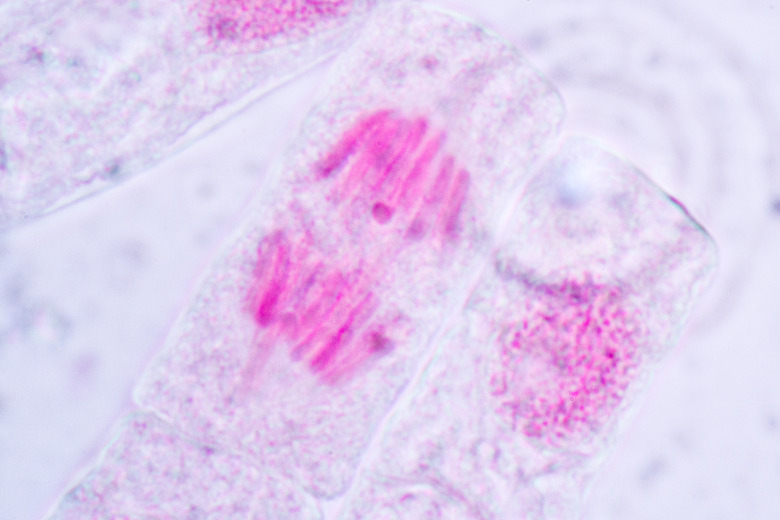What Happens In The Interphase Of The Cell Cycle?
The cell cycle has two main phases, interphase and mitosis. Mitosis is the process during which one cell divides into two. Interphase is the time during which preparations for mitosis are made. Interphase itself is made up of three phases – G1 phase, S phase, and G2 phase – along with a special phase called G0.
G1 Phase
G1 Phase
G1 phase is the time during which the cell makes more proteins so that it can grow to its proper size. The protein concentration within a cell is estimated to be 100 milligrams per milliliter. It is also the time when the cell makes more ribosomes, which are machines that make proteins. A cell will not exit the G1 phase and enter the S phase until it has enough ribosomes. The late end of the G1 phase is also when the mitochondria of the cell fuse together into a network of mitochondria, which helps these organelles become more efficient at producing energy molecules.
Synthesis (S) Phase
Synthesis (S) Phase
S phase, or synthesis phase, is the time during which the cell copies its DNA in preparation for mitosis. Since DNA does not exist by itself in the nucleus but is packaged by proteins, new packaging proteins must also be made to wrap the copied DNA. These package proteins are called histones. The production of histone proteins and the copying of DNA are closely linked. Stopping one process will stop the other. S phase is also the time when the cell produces a lot more phospholipids. Phospholipids are the molecules that make up the cell membrane and the membrane of the cell's organelles. The amount of phospholipid doubles during S phase.
G2 Phase
G2 Phase
The G2 phase is the time during which a cell replicates its organelles in preparation for mitosis. Not only does the DNA need to be divided, but so do the organelles. G2 is the last chance for the cell to make more protein in preparation for division. The cell has twice the amount of DNA during G2 than it did during G1. G2 is necessary for the cell to make sure that all of the DNA is in intact; no breaks and no nicks. The G2 to mitosis transition is the last checkpoint before the cell commits to entering mitosis.
G0 Phase
G0 Phase
G0 phase can occur right after mitosis and right before G1 phase, or a cell in G1 phase can enter G0 phase. Entry into G0 is known as leaving the cell cycle. Cells that mature to become highly specialized cells are said to differentiate. Cells exit the cell cycle and enter G0 in order to differentiate. Terminally differentiated cells are those that never enter the cell cycle again, meaning they stay in G0 and never divide. However, some cells can be triggered to leave G0 and re-enter G1, which allows them to divide again.
References
- The Biology Project: The Cell Cycle & Mitosis Tutorial
- PloS One: Protein Diffusion in Mammalian Cell Cytoplasm
- Cancer Research: Ribosome Biogenesis and Control of Cell Proliferation: p53 is not Alone.
- Proceedings of the National Academy of Sciences: A Hyperfused Mitochondrial State Achieved at G1-S Regulates Cyclin E Buildup and Entry Into S Phase
- Molecular and Cell Biology: Coupling of DNA Synthesis and Histone Synthesis in S Phase Independent of Cyclin/Cdk2 Activity
- Journal of Biological Chemistry: Cell Cycle Regulation of Membrane Phospholipid Metabolism
- Cell Growth & Differentiation: Terminally Differentiated Skeletal Myotubes are not Confined to G0 but can Enter G1 Upon Growth Factor Stimulation
Cite This Article
MLA
Ph.D., David H. Nguyen,. "What Happens In The Interphase Of The Cell Cycle?" sciencing.com, https://www.sciencing.com/happens-interphase-cell-cycle-20315/. 17 April 2019.
APA
Ph.D., David H. Nguyen,. (2019, April 17). What Happens In The Interphase Of The Cell Cycle?. sciencing.com. Retrieved from https://www.sciencing.com/happens-interphase-cell-cycle-20315/
Chicago
Ph.D., David H. Nguyen,. What Happens In The Interphase Of The Cell Cycle? last modified August 30, 2022. https://www.sciencing.com/happens-interphase-cell-cycle-20315/
